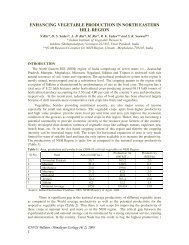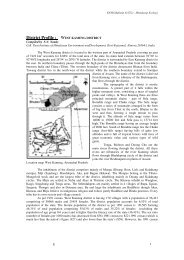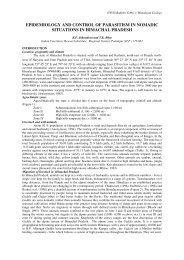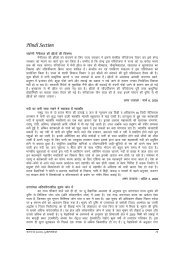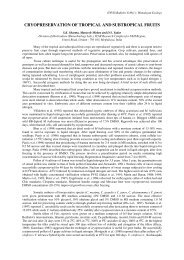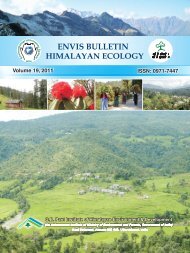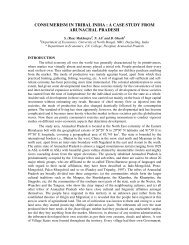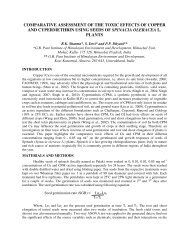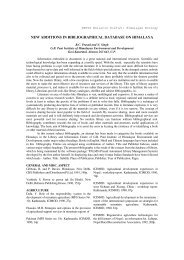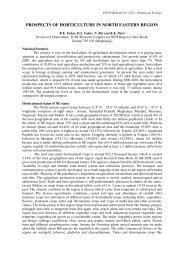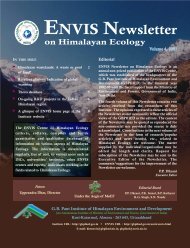ENVIS BULLETIN - ENVIS Centre on Himalayan Ecology
ENVIS BULLETIN - ENVIS Centre on Himalayan Ecology
ENVIS BULLETIN - ENVIS Centre on Himalayan Ecology
Create successful ePaper yourself
Turn your PDF publications into a flip-book with our unique Google optimized e-Paper software.
implementati<strong>on</strong> of the findings of the present, especially to setup the collecti<strong>on</strong> and power generati<strong>on</strong>centers within the study talukas. Based <strong>on</strong> the field surveys, discussi<strong>on</strong> with various stakeholders,including villagers, officials, technical experts and industrialist, the basic amenities, their networking,transport systems and accessibility were c<strong>on</strong>sidered few important criteria to set up such centers.Table 6: Suggested centers for biomass collecti<strong>on</strong> and power plants in the study talukasTaluka Locati<strong>on</strong> for biomass collecti<strong>on</strong> centers Locati<strong>on</strong> for power plants setupRishikesh Thano, Bhaniawala, Shyampur and Raiwala towns Rani Pokhri townPurola Mori, Dhampur and Bhiyal towns Purola townChampawat Lohaghat, Barakot, Pati townsChampawat townAlmora Chaumu, Kande, Dhatwal Ga<strong>on</strong> and KotyuravillagesDarimi village of LamgarhablockBesides developing basic infrastructure, capacity building of local people and setting up oflocal instituti<strong>on</strong>s to meet the basic needs of power generati<strong>on</strong> centers and distributi<strong>on</strong> of powers to thevillagers are other important factors, those need adequate attenti<strong>on</strong> in the planning phase. Capacitybuilding <strong>on</strong> collecti<strong>on</strong> efficiency of biomasss, technical set up and maintenance of power plants anduninterrupted supply of electricity are few important areas for capacity building programme.Regarding distributi<strong>on</strong> of generated power, it could be grid, interfaced with the state grid or couldsupply electricity directly to the local villages and industries, etc. Another opti<strong>on</strong> is to decentralize thepower plants of smaller capacity, which could also be set up in individual villages or cluster of n<strong>on</strong>electrifiedvillages.The findings of the present study reveal that despite the fact that study talukas has lessagriculture area, there is enough potential of surplus biomass to generate about 14.65 MW ofelectricity annually. The potential can be further increased by inputs in the form of capacity building,as menti<strong>on</strong>ed above and also by expanding the afforestati<strong>on</strong> programmes <strong>on</strong> the wastelands andvillage comm<strong>on</strong> lands, which c<strong>on</strong>tribute significantly to the total geographical areas (29.12%) of thestate in general and study talukas (43%) in particular. Not <strong>on</strong>ly this, trends between 1974 and 1994indicate that land under area not available for cultivati<strong>on</strong> is increasing in almost all the districts (Raoand Nandy, 2001). Some of the districts, recording high growth in uncultivated area includedUttarkashi, Pithoragarh, Chamoli and Pauri. The out-migrati<strong>on</strong> of populati<strong>on</strong> for employmentopportunities could be c<strong>on</strong>sidered for such a significant land use changes in the state. Such largechunks of unutilized lands can be brought under plantati<strong>on</strong> programmes for promoting biomass basedenergy generati<strong>on</strong>, which will not <strong>on</strong>ly help in meeting power needs of the rural areas of the state, butat the same time would also generate employment for local communities.ACKNOWLEDGEMENTSAuthors are thankful to the Ministry of N<strong>on</strong>-C<strong>on</strong>venti<strong>on</strong>al Energy Sources (MNES),Government of India for funding the project. Authors greatly acknowledge Uttaranchal RenewableEnergy Development Agency (UREDA), Indian Institute of Science, Bangalore (IISc. Bangalore) andvarious other organizati<strong>on</strong>s who helped in data collecti<strong>on</strong>.REFERENCESCensus of India, 2001. Provisi<strong>on</strong>al Census of India, Government of India, New Delhi.Dua, P.P. and Rao, S.B., 1996. Biomass based strategy for meeting energy needs in rural areas.Biomass Energy System, 111-117.Dutta, A. and Pant, K., 2003. The nutriti<strong>on</strong>al status of indigenous people in the Garhwal Himalayas,India. Mountain Research and Development, 23 (3): 278-283.36E N V IS C entre, G B P IH E D



